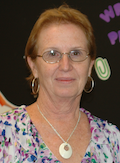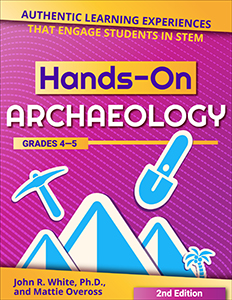Hands-On Archaeology: Digs for Youngsters
Hands-On Archaeology: Grades 4-5, 2nd Edition
By John R. White, Ph.D. and Mattie Oveross
(Prufrock Press, Inc., 2019 – Learn more)
Reviewed by Linda Biondi

Hands-On Archaeology: Grades 4-5 is the book that will revive the excitement in your heart and instill it in your students. So, what is archaeology? Archaeology gives an overview of human history and brings it back to life.

You will find lesson plans that will extend into all areas of the curriculum. Hands-On Archaeology works like an investment portfolio. Students will make intellectual deposits into many areas: Math, biology, geology, art, geography, history, language skills, motor skills, communication skills, data collecting, interpersonal relationships, team building!
This hands-on book is written in an easy-to-understand format with diagrams, practical lessons, easy-to-follow directions, charts, and forms. All lessons are aligned to the Common Core State Standards for Literacy and the Next Generation Science Standards. (A complete standards alignment chart is found at the end of the book.)
Teachers will find the book expertly organized into four sections:
• Introduction to Archaeology
• Preparing the Fieldwork
• The Dig
• Post-Excavation
Introducing archaeology to your students
I was captivated when I read about how to introduce archaeology by hosting a “dig” right in the classroom. Try “excavating” a student’s desk (or better yet, your own desk), or a wastepaper basket with its layers of artifacts. Talk about real life experiences and being able to connect the past with the present! Talk about getting students excited about learning! Talk about giving students a chance to use their imagination to hypothesize, evaluate, collect data, form opinions!
While working in teams, students will learn the importance of collaboration. Yes, it does take a village. It takes working together to plan, refocus, look for strengths in your team, reflect, and meet your goals.
Taking the ‘dig’ beyond the classroom
The beginning of each chapter feels as if you are having a conversation with the authors as they answer any questions you might have about using this process in your classroom. They describe the work the students will be undertaking by describing the “whys” of each activity, the use of key academic vocabulary, and suggestions of alternative ways to use the activities.
Truthfully, before I read this book I wasn’t sure how to teach archaeology. After reading the book, I went from uncertainty to being able to plan, organize, layout and work a dig. This book walks the teacher, and eventually the student, into the thoughts and physical process of archaeology.
Students will become excited as they explore archaeological digs outside of the classroom. The authors explain the importance of being able to find a space that won’t be tampered with by outsiders but is near your school and safe. If this isn’t possible, the book is written in such a way that you will be able to adapt the lessons by using the preliminary activities.
Financing archaeological digs (even locally) can be quite expensive to say the least! Our authors take the bite out of finances by providing the reader with a basic tool kit list. Many items can be found around the house such as dental picks, dustpans, paintbrushes, colanders, atomizers, buckets, hammers, trowels, twine, and pruning shears. If you or your students do not have access to some objects, substitutions such as a knitting needle in lieu of an awl are suggested.
Inspire young archaeologists
This book could actually serve as the backbone of your curriculum. It definitely is a hands-on resource for teachers who want to inspire new and amateur archaeologists to learn more about the past and how the past can shape our future. Students will be able to gain an overview of human history and the science that brings it back to life.
The book is an outstanding educational resource on teaching archaeology in the fourth and fifth grade classroom and can definitely be adapted for upper grades as well. Imagine the excitement students will experience as they put on their archaeologists’ hats and begin their work to discover “artifacts” of the past.
After teaching fourth graders for many years, Linda Biondi is supervising preservice and student teachers at The College of New Jersey and Rider University. Last summer she co-facilitated a week-long writing institute in conjunction with the National Writing Project at Rider University. She volunteers for two service organizations: Homefront and Dress for Success of Central New Jersey – both have a mission to end poverty and homelessness. The mission of Dress for Success is to empower women to achieve through economic independence.































